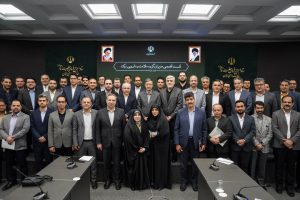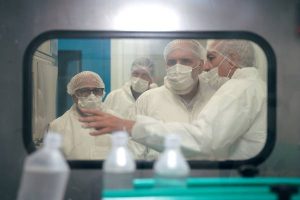
Investment in Iran’s Pharmaceutical Industry
Barekat Health & Pharmaceutical Group: Pharmaceutical industries are one of the strategic and vital sectors in any country, playing a crucial role in ensuring public health, improving the quality of life, and increasing the life expectancy of the population. Given the essential role of drugs in preventing, treating, and controlling diseases, the pharmaceutical industry can become a cornerstone of economic and social development. Iran is no exception to this rule and has been striving, particularly in recent years, to strengthen and develop its pharmaceutical industries, not only to meet domestic needs but also to become an important regional player in drug exports.
Over the past two decades, Iran has sought to enhance its quality and increase its competitive capacity in international markets through investment in research and development, the production of new drugs, and the improvement of technologies related to drug delivery and medical equipment manufacturing.
However, investment in this field has faced numerous challenges that can impact its growth and development. These challenges include international sanctions, issues related to the supply of raw materials, currency fluctuations, and management problems, which collectively hinder the achievement of the overarching goals of this industry.
Current state of investment in pharmaceutical industry
In Iran, the pharmaceutical industry is divided into two main sectors: public and private companies. Both sectors have witnessed significant growth over the decades, but in recent years, private companies and knowledge-based firms have played an increasingly important role in this industry.
Notably, knowledge-based companies have been key in developing new technologies, producing biological drugs, and nanoparticle-based medicines. The Iranian government’s investments in research infrastructure, including the establishment of technology parks and pharmaceutical research centers, have greatly supported the strengthening of this industry.
However, many of these investments have yet to reach full productivity due to financial, technical, and managerial challenges. Additionally, the growth of domestic drug production and efforts to reduce dependency on drug imports have been one of the strategic goals of the government, which requires further investments.
Challenges of Investment
Investment in Iran’s pharmaceutical industry, despite its potential, faces a series of structural and environmental challenges. Some of these challenges include:
International Sanctions: Economic sanctions against Iran are one of the most significant limiting factors in securing raw materials, equipment, and advanced technologies for drug production. These sanctions have not only restricted Iran’s international trade but have also made access to foreign currencies and international financial resources difficult. The result of these limitations has been an increase in production costs and a decrease in the competitiveness of domestically produced drugs in international markets.
Currency fluctuations: Fluctuations in exchange rates in Iran are another serious challenge that has impacted investment in the pharmaceutical sector. Since a large portion of pharmaceutical raw materials is imported, rising exchange rates lead to increased production costs and, consequently, decreased profitability for companies. This issue is particularly critical for small and medium-sized companies with less financial capability.
Raw material supply issues: One of the most significant challenges in Iran’s pharmaceutical industry is the dependency on imported raw materials. This dependency has made securing raw materials a serious challenge for pharmaceutical companies, especially under sanctions and rising currency prices. However, efforts have been made to produce raw materials domestically, although this process requires more investment and support.
Regulatory & bureaucratic hurdles: Complex and sometimes inefficient regulations in Iran pose another barrier to investment in the pharmaceutical industry. Lengthy and complicated processes for issuing permits, importing raw materials, and registering drugs can delay the introduction of new products to the market. Moreover, the lack of coordination between various governmental entities, including the Ministry of Health and the Food and Drug Organization, can create additional challenges for manufacturers.
Shortage of skilled workforce: While Iran has a considerable number of specialized human resources and graduates in pharmaceutical-related fields, there is still a shortage of skilled labor in specific areas such as advanced drug manufacturing technologies and supply chain management. The emigration of talented professionals has also exacerbated this problem.
Lack of foreign investment: Despite Iran’s efforts to attract foreign investments in the pharmaceutical industry, sanctions and banking restrictions have made many foreign companies reluctant to invest in Iran. This situation has led to a reduction in growth and development opportunities for domestic companies. Additionally, limited access to international markets through drug exports has hindered further development of the industry.
Investment Opportunities
Despite the aforementioned challenges, Iran’s pharmaceutical industry still offers numerous opportunities for growth and development. In recent years, significant efforts have been made to develop biological drugs and nanoparticle-based medicines. These drugs can not only meet domestic needs but also have high export potential to regional countries and beyond. Iranian knowledge-based companies can play a vital role in producing these novel drugs through investment in research and development.
With the government’s efforts to reduce dependency on drug imports and increase support for domestic production, demand for domestically produced drugs has risen. This situation can be seen as an opportunity for investment in the production of essential and strategic drugs. Given Iran’s geographical position and close connections with neighboring countries, it can leverage opportunities for drug exports to these countries.
Particularly, the countries in the Middle East, Africa, and Asia represent attractive markets for Iranian-produced drugs. One of the largest investment opportunities in Iran is the production of pharmaceutical raw materials. By reducing dependency on imports, Iran can not only lower production costs but also pave the way for the export of raw materials to other countries.
Conclusion
The pharmaceutical industry in Iran, despite numerous challenges, still has substantial potential for growth and development. By strategically investing in research and development, strengthening international collaborations, and supporting knowledge-based companies, Iran can become an important player in regional and global pharmaceutical markets.
However, to achieve this goal, it is crucial to effectively manage existing challenges, particularly in the areas of financing, currency fluctuations, and international sanctions.
-
Barkat Group specialized meeting

-
Safa Appointed as Barekat General Director

-
Barekat Health & Pharmaceutical Group at the 10th Iran Pharma Exhibition

-
Ali Safa visits Sobhan Oncology & Sobhan Darou

-
Pirsalehi & Safa visit Saman Daroo 8 Knowledge-based Company

-
Barekat Managing Director Visits Samen Pharmaceutical Company

-
Honoring Pharmacists’ Day

-
Barekat Top Executives Visiting to Barekat Hospital

